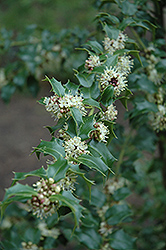It's all about ...
plants

Veitch's Perny Holly
Ilex pernyi 'var. veitchii'
Height: 15 feet
Spread: 8 feet
Sunlight:
![]()
![]()
Hardiness Zone: 7b
Description:
This holly makes a great hedge or screen with its attractive, glossy, large green leaves; it does best in evenly moist, acidic soil
Ornamental Features
Veitch's Perny Holly is primarily valued in the landscape for its ornamental upright and spreading habit of growth. It has attractive green evergreen foliage. The large glossy oval leaves are highly ornamental and remain green throughout the winter.
Landscape Attributes
Veitch's Perny Holly is a dense multi-stemmed evergreen tree with an upright spreading habit of growth. Its relatively coarse texture can be used to stand it apart from other landscape plants with finer foliage.
This is a relatively low maintenance tree, and is best pruned in late winter once the threat of extreme cold has passed. It is a good choice for attracting bees to your yard. It has no significant negative characteristics.
Veitch's Perny Holly is recommended for the following landscape applications;
- Mass Planting
- Hedges/Screening
- Naturalizing And Woodland Gardens
Planting & Growing
Veitch's Perny Holly will grow to be about 15 feet tall at maturity, with a spread of 8 feet. It has a low canopy with a typical clearance of 1 foot from the ground, and is suitable for planting under power lines. It grows at a slow rate, and under ideal conditions can be expected to live for 50 years or more.
This tree does best in full sun to partial shade. It prefers to grow in average to moist conditions, and shouldn't be allowed to dry out. It is particular about its soil conditions, with a strong preference for rich, acidic soils. It is quite intolerant of urban pollution, therefore inner city or urban streetside plantings are best avoided, and will benefit from being planted in a relatively sheltered location. Consider applying a thick mulch around the root zone in winter to protect it in exposed locations or colder microclimates. This is a selected variety of a species not originally from North America.
This plant is not reliably hardy in our region, and certain restrictions may apply; contact the store for more information.
